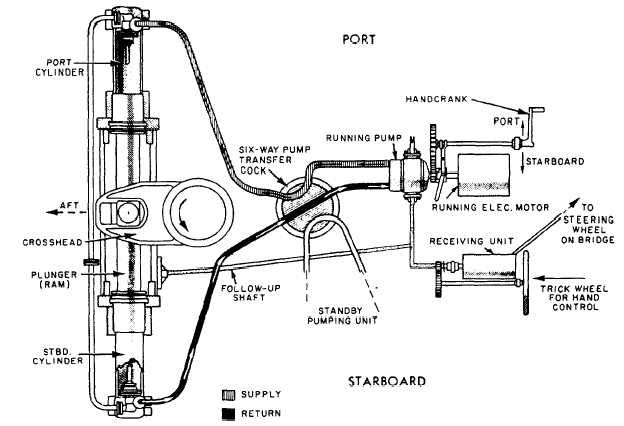| |
The reciprocal of any bearing is its opposite,
meaning that the point or degree is on the opposite side
of the compass card from the bearing. For example, the
reciprocal of 180° is 000°, and vice versa. When you
obtain a bearing on some object, the bearing from the
object to you is the reciprocal of the bearing from you
to it.
To find the reciprocal of any bearing expressed in
degrees, simply add 180° to the bearing. If the bearing
is 050°, for instance, its reciprocal is 050° plus 180°, or
230°. If your bearing is greater than 180°, subtract 180°
to find the reciprocal.
SHIP'S STEERING AND SPEED
CONTROL EQUIPMENT
LEARNING OBJECTIVE: Identify and explain
the operation and usage of the ship's steering
and control equipment.
The ship's steering and speed control equipment
includes many parts and types of equipment. The parts
and types of equipment may change from one ship class
to another, so in the following pages we will discuss the
ones most commonly used in the Navy today.
STEERING ENGINES
When ships began using steam as a means of
propulsion, many problems were created. Foremost was
inadequate hand-powered steering gear. The rapid
increase in the size and speed of steamships resulted in
a correspondingly greater turning effort required at
rudder stocks. Consequently, a natural sequence of
events led to the introduction of steam-powered
steering gear.
Today, there are two types of steering engines. They
are electromechanical and electrohydraulic.
Electromechanical steering gear is found on some small
ships. Most vessels of recent design are equipped with
the electrohydraulic mechanism. A brief discussion of
the types of steering gear follows.
Electromechanical steering gear applies power to
the rudder by means of electromotive machinery.
Because electromechanical gear requires large motors
and considerable maintenance, it has been replaced, to
a great extent, by electrohydraulic gear.
Naval vessels are equipped with electrohydraulic
steering gear. Most destroyers use the single-ram
steering gear, shown in figure 2-6. Aircraft carriers and
some other large ships use a double-ram system.
Figure 2-6— Single-ram electrohydraulic steering gear system.
2-5
|

